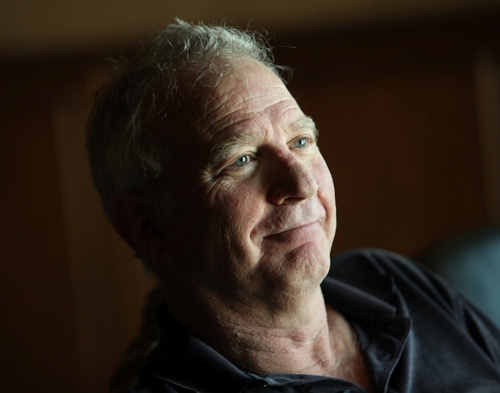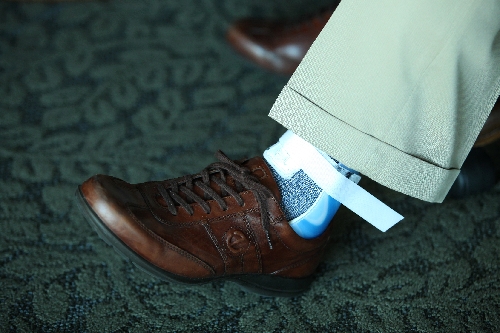Las Vegas man counts blessings as he manages ALS




Call it optimism. Call it analyzing the evidence and coming to a different conclusion than most. Or call it simply making the best choice there is to be made.
But when Rob Dorinson was diagnosed with amyotrophic lateral sclerosis, or ALS, he decided to approach the incurable, ultimately debilitating disease in a way others probably don’t.
“There are a lot of people who are out there that are just kind of waiting to die,” Dorinson says. “I’m not one of those. In fact, I think I’m going to be healed. So I have a somewhat different mental outlook.”
ALS often is known by its pop culture-bestowed nickname, Lou Gehrig’s disease, after the Yankees slugger who had it and whose story was immortalized in the film “The Pride of the Yankees.” For viewers of more recent vintage, ALS is the disease suffered by the title character in Mitch Albom’s nonfiction book, and later TV movie, “Tuesdays with Morrie.”
ALS occurs in one or two people per 100,000, says Dr. David Ginsburg, an associate professor of neurology at the University of Nevada School of Medicine.
“We don’t know the cause,” Ginsburg says. Five percent to 10 percent of cases are “thought to be hereditary,” he says, while the rest are “what we call sporadic; in other words, they’re not hereditary and there’s maybe more than one cause and we don’t really know for sure.”
In ALS, motor neurons – which send impulses from the brain and spinal cord to muscles in the body – degenerate progressively, until the brain no longer can communicate with or control the muscles.
Or, as Dorinson explains it, the brain continues to send messages, but the messages are interrupted before they can reach the muscle.
Muscles that can be affected by ALS include those that control the arms and the legs and walking and movement – patients in later stages may be unable to move at all – as well as the muscles that control swallowing, chewing, speech and breathing.
The average age of onset of ALS is between 40 and 60, Ginsburg says, “although I’ve certainly seen people into their 70s and 80s with this, and I’ve seen younger patients. I’ve even seen teenagers with it.”
For Dorinson, ALS couldn’t have announced itself more subtly or more innocuously.
Dorinson, a San Francisco native who came to Las Vegas in 1982, says he’s always possessed an entrepreneurial sort of mindset. He has worked in industrial real estate and custom home construction, and in 1997 he founded Evergreen Recycling.
And, says Dorinson – who’s still a youthful-looking 61 – “I was always very active athletically. I have a trainer. I work out very hard four days a week. I was a hiker and a fisherman and an avid outdoorsman.”
Then, looking over at the mobility scooter that with a cane and a walker now make up his ambulatory arsenal, Dorinson smiles.
“I had this thing against ATVs,” he says, “but they don’t look so bad now.”
In 2008, Dorinson began to feel unusual muscle stiffness. “I’d wake up in the morning, and I had to go downstairs and lay on the floor and stretch to really get moving,” he recalls.
Then he began to notice weakness in his left foot.
“By that, I mean it sort of dropped a little,” he says. “It wasn’t as strong.”
About a year later, Dorinson was walking through an airport to retrieve his bags. “When I got there, I looked for a place to sit, which is very unusual for me,” Dorinson says.
Ginsburg says Dorinson’s symptoms aren’t unusual. The subtlety of the symptoms with which ALS manifests itself can make the condition easily ignored by patients or misdiagnosed by physicians.
For example, Ginsburg says, the foot drop associated with ALS often is misdiagnosed as a pinched nerve in the back. That was basically the case for Dorinson, who went to a doctor, underwent tests and was told that his foot drop could be related to a bulging disc.
However, as time passed, Dorinson’s muscle weakness worsened.
“I was skiing and I was having a hard time turning right – which, you use your left foot to turn right,” he says. “After about an hour, I quit. The next day, I was walking with my wife, and she used to have to run to keep up with me, but I was having to run to keep up with her.”
Dorinson also began to notice muscle twitches in his upper arm. Convinced that something wasn’t right, he consulted his father, a San Francisco physician. In mid-2010, Dorinson underwent more tests and saw a neurologist.
“She said, ‘Just walk for me,’ and she diagnosed it right away,” Dorinson says. “Of course, she said: ‘We have to confirm it with some tests.’ “
Her diagnosis: ALS, a disease Dorinson at the time had little reason to know anything about.
“I mean, everybody has seen Gary Cooper in ‘Pride of the Yankees’ ” Dorinson says. “I remember asking my dad when we saw the movie, ‘What is that?’ He told me and said, ‘Yeah, it’s a devastating illness.’ “
ALS treatment lies primarily in addressing the medical issues it brings. That might include using leg braces, wheelchairs and walkers to compensate for muscle weakness and decreased mobility, alternative nutrition for people who no longer can swallow, and medications that can help such ALS-related problems as excessive salivation and muscle cramps.
However, ALS has no cure. Ginsburg said a patient’s average life expectancy after diagnosis is three to five years.
“I’ve had patients who have lived longer. I’ve had patients who have lived up to 10 years,” he says. “I’ve had patients survive six months or less. Part of it depends on where it starts.”
Dorinson recalls that when the neurologist told him he had ALS, “she told me basically to order a wheelchair and get my affairs in order.”
Doing research on his own, Dorinson discovered that ALS advances at all stages of the disease, but that it advances at different rates.
“Some people get it and go right off the cliff,” he says. “Some people, it’s just more gradual.”
Dorinson also learned that being diagnosed at an older age may have been a good thing, comparatively speaking, because “supposedly, the later it comes, the slower it progresses. That’s not always the case. As I understand it, no two cases are the same.”
Having experienced initial symptoms in his feet and his arms also may have been good, all things being equal, because it means the disease may take longer to progress to the muscles in his throat and chest, where it’s more likely to affect breathing.
Dorinson and his wife of 13 years, Lori, have four children, ages 22 to 27. How did he break the news to his family?
“Well, the way we broke it was that I have this affliction. That according to doctors it’s going to be slow and progressive. I’m not going anywhere tomorrow. I’ll be around. So that’s kind of how we did it: There’s not going to be any immediate disruption in the family.”
Dorinson brought to living with ALS the same analytical, problem-solving skills he always used in business. He got braces for his legs, a walker to get around and a mobility scooter for traveling longer distances. He continued – and continues to this day – his exercise program, albeit one somewhat altered so as not to overtire him. He tries to manage stress, takes nutritional supplements and pays more attention to his diet, eating organic foods and eating cleanly.
“I’m still 98 percent functional,” he says. “I can dress myself. I can shower. I can shave.
“There are certain things that are hard. Opening bottles. Buttoning buttons. I could tie my shoes, but it’s easier if someone else does it. So you learn what you can do and then adapt.”
Rather than thinking about the things he no longer can do because of ALS, “you have to focus on what you can do, with the idea that you can get back to them,” he says.
That includes finding ways to continue doing the things he loves. For instance, he says, “I’m trying to figure out how I can fish. And maybe I have to fish not in a stream but, maybe, I’ll have to sit on a dam and throw a bobber. But I will be able to catch a fish.
“The question is, how do you enjoy life to the fullest when you’ve got a hand tied behind your back?”
But altering daily routines and finding ways to perform activities is only half the battle. There also is Dorinson’s continuing focus on living with the knowledge that he has ALS and of what having it ultimately will mean.
“The mental part is as tough as the physical part,” he says.
“To me, it was sort of a transformation over the past year or so. And I’m talking about the highs. There certainly have been some valleys and, those, unfortunately, we all go through them.”
But, Dorinson says, it comes down to making a choice to stress the positive and the hopeful rather than dwell on the negative and the fear.
“It’s really what you focus on,” he says. “If you focus on healing, it’s going to help. And it’s not a crossroad you hit once and that’s it. It’s a crossroad you hit many times.”
Contact reporter John Przybys at
jprzybys@review journal.com or 702-383-0280.
ALS of Nevada provides a variety of services to ALS patients, their caregivers and their families, including information, referrals and assistive devices.
The nonprofit organization also offers a free monthly multidisciplinary clinic. Dr. David Ginsburg, an associate professor of neurology at the University of Nevada School of Medicine, says the clinic offers “very good one-stop shopping for patients. We work with respiratory therapists, speech therapists, physical therapists and dietitians, and we also have durable medical equipment.”
Call 777-0500 for more information.












